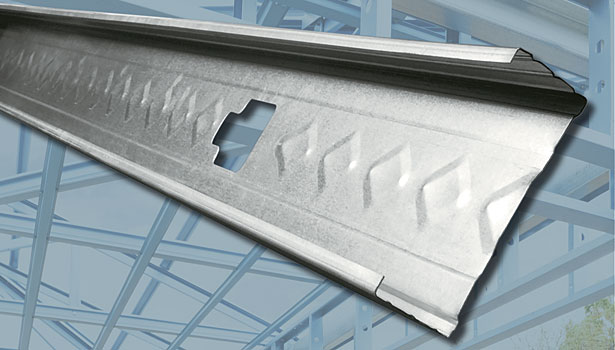EQ Coating for Steel Studs

EQ studs are produced by a number of manufacturers and vary in performance. Products such as ProSTUD with DiamondPlus coating by ClarkDietrich Building Systems utilize new corrosion-inhibiting and adhesion-enhancing formulas to greatly improve the corrosion resistance of steel framing members


This side-by-side comparison shows the rust area of EQ-coated steel and G40 steel samples after 240 hours of salt spray testing.





The durability of cold-formed steel framing depends greatly on its ability to resist corrosion. Untreated steel has a natural tendency to corrode, or oxidize, when exposed to moisture. For this reason, most nonstructural steel framing is manufactured with protective coatings that prevent moisture from reaching the steel substrate. While most in the industry are familiar with standard coatings like galvanized and galvanealed, the use of EQ or equivalent coatings has been growing in popularity, due primarily to their superior corrosion protection. Though “newer” to the construction industry, these coatings have actually been used for several decades, account for a significant portion of the nonstructural cold-formed steel stud market, and meet or exceed International Building Code requirements. Although many in the construction industry have embraced EQ coating technology, others have been slow to do so. The following is a look at why contractors should feel confident when selecting EQ coated studs for their nonstructural steel framing projects.
Permanently Bonded Corrosion-Resistance
EQ coatings, also referred to as organic, inter-reactive, reactive polymer coatings or conversion coatings, are added to zinc-coated steel coils to enhance the corrosion resistance of the existing base coating. This additional coating is applied to the steel used to form the metal studs through a reverse roll coating process and is then cured at an elevated temperature to ensure completion of the bonding process.
EQ coatings should not be confused with paints, primers or barrier coating systems, which are penetrable and allow corrosion when scratched on the jobsite, or while the product is in transit. An EQ coating forms a permanently bonded layer that protects against corrosion by way of a chemical reaction, which also penetrates into any cracks or voids of the existing coating. This reaction seals off the zinc layer, as well as the carbon steel base metal below it, to prevent the formation of an oxide or rust layer. Through this process a singular composite coating is produced.
To keep steel stud costs affordable for the construction community, manufacturers who produce EQ coated steel studs procure much of the base steel from the automotive industry. This sourcing, which helps reduce post-production waste from auto manufacturers, gives steel stud makers a high quality, zinc-coated recycled substrate to which EQ coatings are applied. It’s an effort that also may contribute LEED credits into construction projects.
The steel framing industry is not the only industry to implement this coating concept. In fact the practice has been embraced by the transportation, military, off-shore drilling and other industries. Its integration and acceptance into the manufacturing of nonstructural cold-formed steel studs has been a move toward a stronger, more sustainable future for the construction industry.
Meet Building Codes
The current edition of the International Building Code lists ASTM C645, Standard Specification for Nonstructural Steel Framing Members, as its governing industry standard for the performance of nonload-bearing steel studs. This industry-accepted standard states with respect to coatings that “Members shall have a protective coating conforming to Specification A653/A653M-G 40 minimum or shall have a protective coating with an equivalent corrosion resistance.” The equivalent provision has been part of the code for more than 20 years. To that end, cold-formed nonstructural members with EQ coatings have actually proven to perform beyond the standard required by ASTM C645.
In addition to ASTM standards, a new industry standard via the American Iron and Steel Institute is on the horizon. AISI S220: North American Standard for Cold-Formed Steel Framing—Nonstructural Members has been adopted into the upcoming 2015 version of the International Building Code and will likely replace ASTM C645 as the universal industry standard for the specification of nonstructural steel framing in the coming years. Similar to the current benchmark, AISI S220 states that “Nonstructural members utilized in cold-formed, steel-framed constructions shall have a protective coating conforming to ASTM A653/A653M-G40 minimum or shall have a protective coating with an equivalent corrosion resistance.”
Surpass Standard Performance Requirements
Steel studs with EQ coatings have proven their strength through successful jobsite applications, but a better indicator may be their demonstrated performance in the destructive ASTM B117 salt spray test. This is the industry test that proves EQ-coated steel studs surpass the requirements of the previously noted ASTM C645.
Results from a multitude of salt spray tests conducted at many different laboratories over many years consistently reveal that EQ coatings exceed the performance level of standard G40 coated steel. During the tests, G40 steel samples that included an additional chemical treatment protective coating began failing at 120 hours of exposure to salt spray and rapidly reached the 10 percent failure threshold at 192 hours on average. By comparison, EQ coated samples did not climb above 5 percent surface rust, even after 240 hours of exposure. Further, each test was run beyond the 10 percent surface rust failure point of G40 steel. After thousands of tests the EQ coated samples consistently outperformed the G40 coated samples in salt spray exposure. Testing was conducted in accordance with the ASTM B117 standard and was performed at accredited laboratories.
Conclusion
The use of high-performing materials and products has become an important strategy in the design and construction of today’s new buildings. These materials play a crucial role in the efficiency, sustainability and overall performance of a building. Therefore, every product on the project counts, right down to the choice of the nonstructural steel studs. Selecting proven products, such as steel studs with EQ coatings for nonstructural framing, will help create a more affordable, sustainable and durable structure.
Looking for a reprint of this article?
From high-res PDFs to custom plaques, order your copy today!











